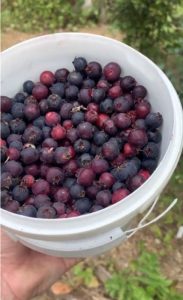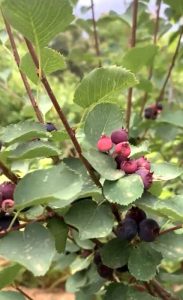Juneberry tree (Amelancheir arborea)
Jaimie Sweetman is Head Gardener of the Edible Forest located on the Yarra Valley Estate in Dixons Creek. There are regular tours of the Edible Forest, often led by Jaimie – read more and book your place on a future tour.

 The juneberry tree is one of our favourites in the forest – a small tree that really gives!
The juneberry tree is one of our favourites in the forest – a small tree that really gives!
In autumn, it is a flush of red deciduous leaves, followed by cream flowers in spring. But the berries are the main stars! They ripen from pink to a deep purple and taste a little like bubble gum. Whilst they look a bit like blueberries, they are actually more closely related to apples (both being in the rose family – rosacea).
Coming from North America and sometimes called serviceberries or sugar plums, they are not often seen in Melbourne, nor are they easy to find here. If you do stumble upon one, it’s a great find! If not, then the one in our forest fruits through December and is worth the visit!
Another member of the Amelancheir genus is the saskatoon (Amelanchier alnifolia), which is smaller (only grows to shrub size) and much easier to find in Victoria (although still not common).
[Editor: the juneberry is so-called because the berries set in June. But that, of course, is in the Northern hemisphere and is the equivalent of December in Australia. So maybe we should be calling it the Decemberberry.]

Is juneberry a weed if grown in Australia?
Are juneberries infected by fruit fly?
I think that they can be.